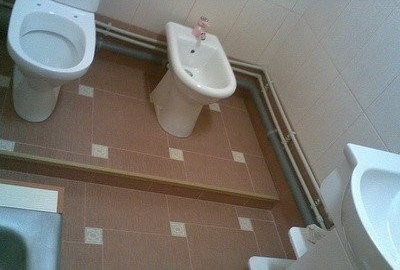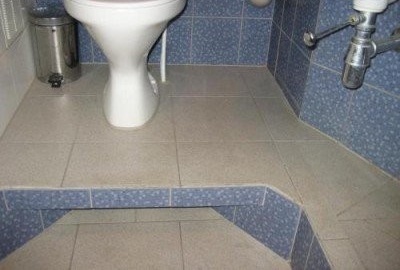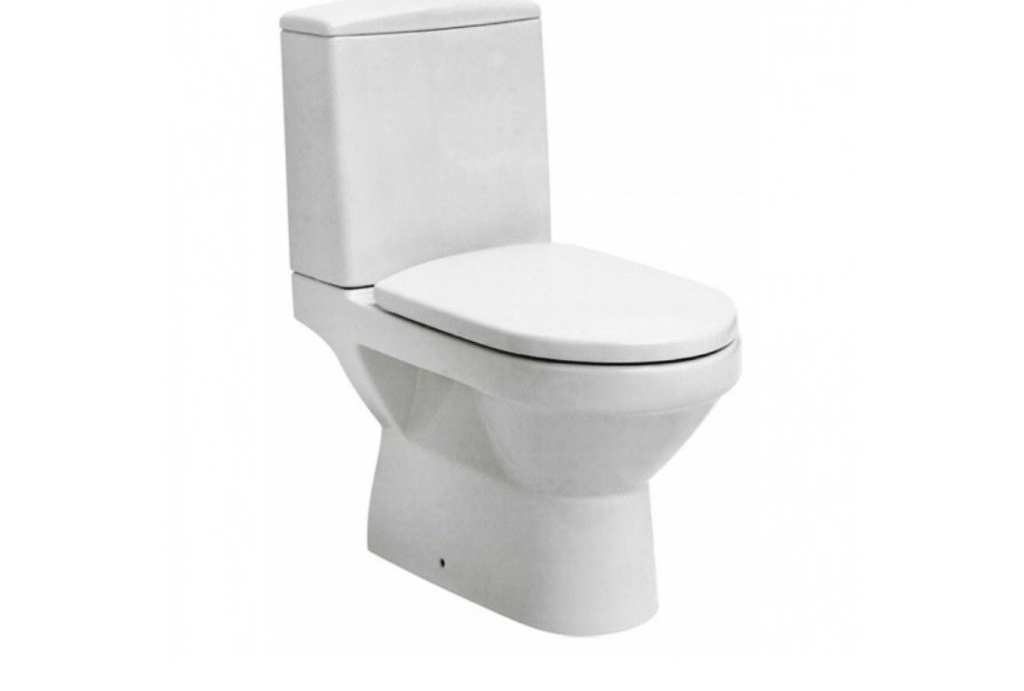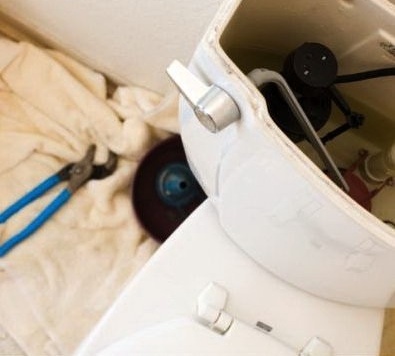Moving the toilet from the riser to another place: when design is more important than anything else
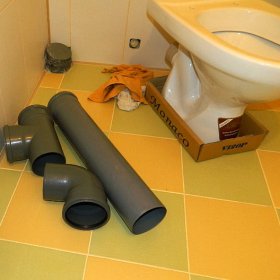
The bathroom of a standard apartment most often has a small area, so the owners of the room have to “use” to the maximum every centimeter of free space. The result of design research quite often is the desire to move or deploy the toilet. This is a responsible and difficult event. You can invite experts to conduct it, but you can do it yourself. Let's figure out how to do all the work correctly.
Content
"Pitfalls" of these works
At first glance, moving sanitary equipment some distance from the riser seems a very simple and problem-free solution. But in reality this is not so. An increase in the length of sewer pipes suitable for equipment threatens trouble. When flushing, excessive vacuum will occur in them, which will provoke a breakdown of the water seal in all nearby plumbing fixtures. This process will be accompanied by extremely unpleasant odors from the sewer and gurgling sounds.
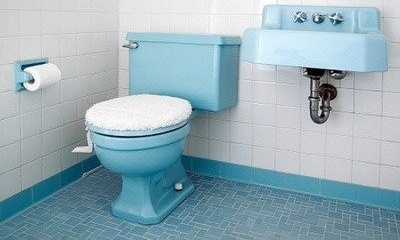
Often, only the transfer of plumbing equipment to a certain distance from the sewer riser can solve the problem of optimizing the space in the bathroom
Another problem is the increased likelihood of blockages. When moving equipment, the length of the pipe that connects the device to the sewer riser increases. Accordingly, the path of sewage is lengthened. Theoretically, in any case, sewage will reach the sewage system, however, the likelihood of clogging increases many times. Both problems can be solved with strict observance of the requirements of the current SNiP. The document prohibits removing the plumbing fixture from the pipe further than 1.5 m.
Another important indicator is pipeline slope. For parts with a diameter of 100 mm, it should be at least 2 cm per meter. Parts with a diameter of 50 mm must be laid with a slope of at least 3 cm per meter. This requirement is mandatory for accurate execution. Reducing the slope reduces the rate of runoff, which can cause blockages. Too large a slope is also undesirable. In this case, the water will pass through the pipes too quickly, leaving solid impurities. They will gradually accumulate inside the pipes, preventing the free outflow of fluid.
Very often, the owner of the bathroom understands that to ensure a sufficient slope of the sewer pipe, the toilet will have to be raised, and the lifting height can be quite large. It all depends on the diameter of the pipe and the distance over which the device must be removed.There can be two solutions to the problem: either raise the floor in the bathroom and mask the pipeline in it, or install a kind of podium under the toilet. Both options are quite viable, but in practice the second is most often used. As the least time-consuming and fairly convenient solution.
When planning equipment transfer, one more thing to consider. The pipeline laid from the riser to the toilet should be a line without right angles. In cases where this is not possible, instead of a sharp bend of 90 °, you need to arrange two turns of 45 °. This is necessary to minimize the risk of clogging.
SNiP sets rather stringent requirements for the transfer of a plumbing fixture and all of them must be fulfilled without fail, otherwise problems with the operation of the equipment cannot be avoided. At the same time, you need to understand that if the toilet needs to be moved more than 1.5 m, the SNiP recommendations will not “work”. In this case, you must either transfer the sewer riser itself, which is almost impossible, or equip a forced sewer. The latter option can also be used with a shorter distance from the riser to the toilet, provided that there is no possibility or desire to tinker with laying the pipe with the desired slope and raising the floor level in the bathroom.
Toilet transfer technology
The equipment can be moved to different distances, with different angles of rotation of the device. Depending on this, a simple transfer option and a more complex one are distinguished.
Option # 1 - transfer of 10-20 centimeters
It is assumed that the equipment is transported to a small distance, which does not exceed 10-20 cm. We begin by dismantling the old device. If the device was “planted” on cement or glue and its release is also coated with cement, you will have to tinker with its dismantling. One wrong move - and the toilet will split. If you plan to install a new device, you can not be careful with the old one, if this is not so, turn off the water and very carefully perform the following operations:
- We free from putty from the space between the outlet of the device and the sewer socket. For carrying out manipulations, you can use a narrow chisel or a strong screwdriver.
- Carefully loosening the toilet. To do this, carefully hammer a wide chisel under the base in different places. Repeat the operation until the device starts to swing.
- Raise the toilet. First, we feed the device to ourselves and take out the outlet from the socket of the sewer pipe strictly along its axis. Plumbers warn that if the device gets stuck and will not come in, you cannot pull it too much. It is necessary to carefully swing the device, and then pull it again.
Equipment installed on standard fasteners and connected to the sewer with a rubber cuff can be removed much more easily. To dismantle it, you will need to unscrew the screws that secure the device. After that, we feed the device to ourselves strictly in the direction of the axis of the sewer pipe and remove the outlet from it.
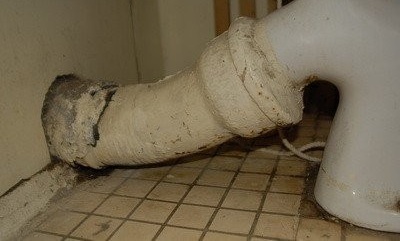
If the toilet should remain operational after dismantling, all operations are carried out very carefully. The putty that secures the release of the device in the sewer socket is destroyed very carefully
After carrying out all the work, you can begin preparations for installing the device in a new place. Inspect the old flexible eyeliner. If its length is not enough or it leaks, we change it to a suitable model. If the part is in good condition, we leave everything as it is.
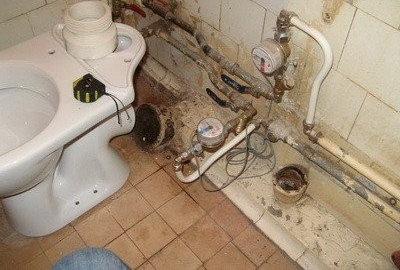
A toilet bowl connected to a bell with a corrugation is much easier to dismantle. You only need to remove the fixtures from the device and remove the flexible corrugation
To connect the release of the toilet with the socket of the sewer, you will need a corrugation.Despite the fact that rubber seals are installed at its two ends, it is worth using silicone sealant for safety reasons. In addition, you need to prepare special fasteners. It is very important that the steel fasteners are not pressed against the sanitary ware, so the presence of plastic washers on the mounts is mandatory. Then install the device:
- We plan on the floor places for mounting. We drill holes. If you have to work with tiles, first we pass the tile with a special drill of a slightly larger diameter.
- We clean the sewer socket and the toilet and wipe them dry.
- Apply silicone sealant to the corrugation. We put it on the release of equipment.
- We install the device in place, insert the fasteners into the prepared holes and carefully tighten them. After the device ceases to stagger, tighten the fasteners immediately stop.
- We cover the remaining gaps between the floor and the base with a solution. Thus, we create an additional support, which will not allow lateral force to destroy the base.
- We coat the second part of the corrugation with sealant and insert it into the bell.
It must be remembered that the toilet is a rather fragile bathroom, so you need to act very carefully.
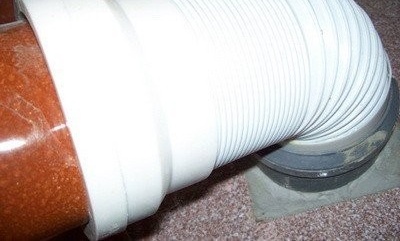
Corrugation is a flexible connecting element, which greatly facilitates the connection of the toilet to the sewer. Its main disadvantage is fragility.
Option # 2 - long distance transport
If you have to transfer the device to a distance that exceeds the length of the corrugation, you will need to rework the sewer. The dismantling procedure and subsequent installation of the device is no different from the above described option. The difference is the increase in sewage. For this procedure, a plastic pipe with a diameter of 110 mm is most often used. The number, length and configuration of the connecting elements depend on the new location of the toilet. A plastic pipe is laid on the floor or attached to the wall with special clamps.
There are several nuances to which special attention should be paid. To lower the sewer to the floor level, you will have to extract a tap to the toilet from the cross or tee. For plastic elements it is not difficult. If the parts are made of cast iron, it is best to first heat the bell with a gas burner or blowtorch. This is done so that the seal burns out and the cement putty is cracked. Compounds filled with sulfur are also annealed with a blowtorch. In this case, a very strong unpleasant odor appears. It is imperative that you use a gas mask and ventilate the room well.
After that, removing the pipe from the socket is not difficult. It is best to start installing a new pipeline from a riser. At the same time, do not forget about the necessary slope, which is about 1-2 cm per linear meter. To install a plastic pipe in a cast-iron socket, it is optimal to use a special cuff seal. It is best to install it by pre-coating the joint with silicone sealant.

The installation of the toilet with special fasteners must be carried out very carefully. It is important to remember that steel screws should not touch the sanitary ware. When installing them, be sure to use gaskets
The toilet can be connected with corrugation, This is considered the simplest, but at the same time short-lived option. It is applied only when it is possible to provide unhindered access to the connecting element. A special adapter pipe can be used, which is installed somewhat more complicated than the corrugation, but gives a more reliable and durable connection. A connection using linen winding can also take place. This is an outdated, but quite reliable option.
Is it worth it to do this work yourself?
Moving a plumbing fixture from a riser is a rather complicated undertaking.It is very important to correctly calculate all the transfer parameters, determine the correct pipe slope, the location of the device and, if necessary, accurately select the forced sewage system. The slightest errors in the calculations or installation can lead to very unpleasant difficult to solve problems in the form of chronic blockages and an unremovable unpleasant smell in the bathroom.
Anyone who does not have real experience in installing plumbing equipment can be advised to seek help from specialists. Professionals will evaluate the existing conditions, help you choose the necessary equipment and correctly install it. The toilet will be delivered exactly where the owner wants, and will function flawlessly.
